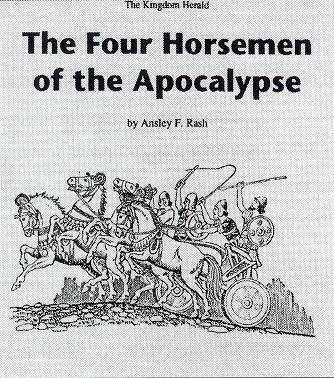THE FOUR HORSEMEN OF THE APOCALYPSE
AS the curtain rises four horsemen ride forth, following one another across the stage. The horse is symbolic of the Roman power and was the emblem of that iron Empire during the first three centuries of the Christian era. I have held in my hand coins minted by Imperial Rome bearing upon them these four horsemen, exactly as they appear in the Bible.
The first to appear is the White horse, emblem of peace and prosperity, portraying the period of Roman history known as the Golden or Augustan Age. During this era, from A.D. 98-180, famous emperors whose names are very familiar, such as Nerva, Trajan and Hadrian, conquered half the world and made Rome the greatest of all Empires.
The bow was a Cretan symbol, and Nerva, the first emperor of that period, was a Cretan.
The crown or coronet was a fitting symbol of the diadem worn by these emperors.
The jewelled imperial crown did not appear until A.D.99 in the reign of Diocletian.
Next the stage is darkened by the Red horse of war, fit symbol of the period from A.D. 185-284. Civil and internal strife rent the empire as generals and consuls struggled for the imperial purple.
From A.D. 192-284 the conflict was at its worst, commencing with the assassination of Commodus and ending with the accession of Diocletian.
Gibbon, in The Decline and Fall of the Roman Empire (volume 1 chapter 6 page 153) says
“The dissolute tyranny of Commodus, the civil wars occasioned by his death, the new maxims of policy introduced by the House of Severus, had all contributed to increase the dangerous power of the army, and to obliterate the faint image of laws and liberty that was still impressed upon the minds of the Romans. This internal change undermined the foundations of the Empire”.
It should be noted that the messages here given dovetail into each other and the events portrayed under one symbol run parallel with those portrayed under another symbol.
The appearance of the Black horse and its rider reveals a picture of depression and want, with heavy taxation from the government holding the balances which should have spoken of justice and equity. From A.D. 212 to A.D. 217 the Emperor Caracalla and his successor oppressed the people and heaped upon them burdens grievous to be borne. This taxation to maintain the army and the extravagant administration of the Empire proved to be so burdensome that agriculture was ruined and fertile provinces were left uncultivated in desolation, depression and gloom.
As a natural result of the foregoing, the Pale horse of death and decay rode to and fro in the Empire. From A.D. 248 to A.D. 268 barbarians and military tyrants overran the Empire and afflicted the people, and twenty years of shame and tragedy passed over the Roman world.
From A.D. 250 to A.D. 265 a furious plague raged throughout the Empire, affecting almost every family. Five thousand persons died daily for some time in Rome alone, and famine swept through the land.
Here we have the last appearance of the horse, symbol of the united Empire, for in A.D. 292 Diocletian divided it into four parts, each with its own sovereign ruler. Thus history records the accuracy of each minute detail and reminds us that ‘not one of these shall fail’.
Courtesy: The Kingdom Digest, U.S.A.


